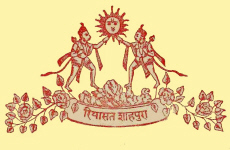SHAHPURA

BRIEF HISTORY
Daulat Singhji died at the Battle of Bijapur in 1685, leaving his estates to his only surviving son, Bharat Singh. This prince was, like his ancestors, a brave and distinguished soldier. He served Aurangzeb, who rewarded him with the title of Raja and erected his properties into a separate principality in 170 6. His son, eager to obtain power, imprisoned him and usurped the throne in 1729. Raja Bharat Singhji later died in confinement probably poised by the new Raja's agents.
Raja Umaid Singhji reconciled himself to the head of the clan, the Maharana of Udaipur, and received the pargana of Kachola in reward for his loyalty. He was one of the first Rajput princes to join forces with the Maratha powers and served with them against the Mughals. He too died valiantly at the famous Battle of Ujain in 1769. His son, R aja Ram Singhji, received the title of Svasti Shri, largely in recognition of his father' s services. Ram Singhji's successors reigned without much note.
Raja Nahar Singhji acceded to the gadi in 1870 after his adoption on the failure of the main line. He was a descendant of Zalim Singh, the preferred heir of Umaid Singhji I. A hugely energetic and kind hearted man, who took his position as guardian of his people very seriously, immediately began the transformation of his little state. He built hospitals, s chools and roads. He established a system of local government and encouraged public participation in state affairs. During a period of serious drought he even pawned the state jewellery and family heirlooms in order to construct two large irrigation tanks . Not only did they help alleviate its worst effects; the construction provided work and income for otherwise idle farmers. His services were recognised and rewarded by the British several times, including secure recognition as a ruling prince, independent of the Maharana of Udaipur. He died full of years and honours in 1932.
Raja Umaid Singhji II succeeded his father, but was faced with the new nationalism then on the march throughout India. He continued much of his father's good works, having served as hi s chief minister and partner in the administration for twenty years. However, he was not entirely sympathetic to the new factions arising to powers and felt that the state needed leadership of a different generation. Therefore, he abdicated in favour of h is only son and heir in February 1947, leaving him to decide on the little state's future.
Raja Sudershandev Singhji had been on the gadi six months when the momentous events of independence, British withdrawal and partition engulfed India. Like most Rajpu t rulers, he had no difficulty in opting for India in 1947. Two years later Shahpura merged with those states into the Greater Rajasthan Union. He died in 1992 and was succeeded by his only son, Rajadhiraja Indrajeet Deo, who has transformed the family pa lace into a beautiful luxury hotel. A green haven in an otherwise dry desert, the result of his great grandfather's labours to bring water to his people.
SALUTE:
9-guns (1925).
FLAG:
Based on the traditional 'Panchranga' of five, equal, horizontal bands of green, dark blue, yellow, red and white.
STYLES & TITLES:
The ruling prince: Svasti Shri Rajadhiraja (personal name) Sahib Bahadur, Raja of Shahpura, with the style of His Highness.
The consort of the ruling prince: Shri Rani (personal name) Sahiba.
The Heir Apparent: Maharajkumar Shri (personal name) Sahib.
The younger sons of the ruling prince, during their father's lifetime: Rajkumar Shri (personal name) Sahib.
The brothers of the ruling prince, after the death of their father: Maharaj Shri (personal name) Sahib.
The daughters-in-law of the ruling prince: Rani (personal name) Bai Sahiba.
The daughters of the ruling prince: Rajkumari (personal name) Bai Sahiba.
The sons of a Maharaj, during their father's lifetime: Rajkumar (personal name).
Other male descendants of previous ruling princes, in the male line: Kunwar (personal name).
Other female descendants of previous ruling princes, in the male line: Ba Shri (personal name) Bai Sahiba.
ORDERS & DECORATIONS:
None known.
RULES OF SUCCESSION:
Male primogeniture, with the right of adoption by the recognised head of the family on the failure of natural male heirs.
SOURCES:
A Brief History of the Shahpura State. Ajmer, 1930.
A Brief Record of the Shahpura Status Case. Vedic Yantralaya Press, Ajmer, 1926.
Annual Administration Report of the Shahpura Chiefship. 1909/1910-1910/1911, 1912/1913-1924/1925. IOR/V/10, British Library, St Pancras, London.
Annual Administration Report of the Shahpura State. 1925/1926-1934/1935. IOR/V/10, British Library, St Pancras, London.
Annual Report on the Administration of the Shahpura State. 1935/1936-1941/1942. IOR/V/10, British Library, St Pancras, London.
Alexander Kinloch Forbes. Ras-Mala, Hindu Annals of Western India, with particular reference to Gujarat. Heritage Publishers. New Delhi, 1973.
The Rajputana Gazetteer. Volume II. Office of the Superintendent of Government Printing, Calcutta, 1879.
The Ruling Princes. Chiefs and Leading Personages in the Western India States Agency, 1st edition. Rajkot, 1928.
The Ruling Princes. Chiefs and Leading Personages in the Western India States Agency, 2nd edition. Manager of Publications, Delhi, 1935.
SPECIAL ACKNOWLEDGEMENT:
Father Lawrence Ober, SJ.
CopyrightęChristopher Buyers, February 2007 - May 2021